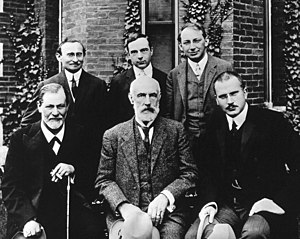Our website is made possible by displaying online advertisements to our visitors.
Please consider supporting us by disabling your ad blocker.
Psychoanalysis


Psychoanalysis is a field of psychology and medical therapy. It is a set of theories and ways of treating mental disorders. It was started in the early 1890s by the Austrian psychologist Sigmund Freud,[1] with experience from the clinical work of Josef Breuer and others.
Since then, psychoanalysis has expanded and been revised, reformed and developed in different ways. Freud's own colleagues and students, such as Alfred Adler and Carl Jung, had their own ideas. They went on to develop their ideas independently from Freud. Much later, Anna Freud and Melanie Klein used the ideas to treat troubled children.
The basic ideas of psychoanalysis are:[2]
- besides inherited personality, a person's development is determined by events in early childhood;
- human behavior, experience, and thought is largely influenced by unconscious irrational drives;
- attempts to bring these drives into awareness is resisted by defence mechanisms;
- conflicts between conscious and unconscious (repressed) material can result in mental disturbances such as neurosis, neurotic traits, anxiety, depression, etc.;
- liberation from the effects of the unconscious material is achieved by bringing this material into the conscious mind (e.g. by the skilled guidance of the analyst.[3]
- ↑ Freud S. 1940. An outline of psychoanalysis. (The standard edition of the complete psychological works of Sigmund Freud, volume XXIII)
- ↑ Freud, Sigmund 1922. Introductory lectures on psycho-analysis: a course of twenty-eight lectures delivered at eh University of Vienna. Authorised English translation by Joan Riviere with a Preface by Ernest Jones. London: Allen & Unwin.
- ↑ Erich Fromm 1992. The revision of psychoanalysis, p13/14.
Previous Page Next Page


